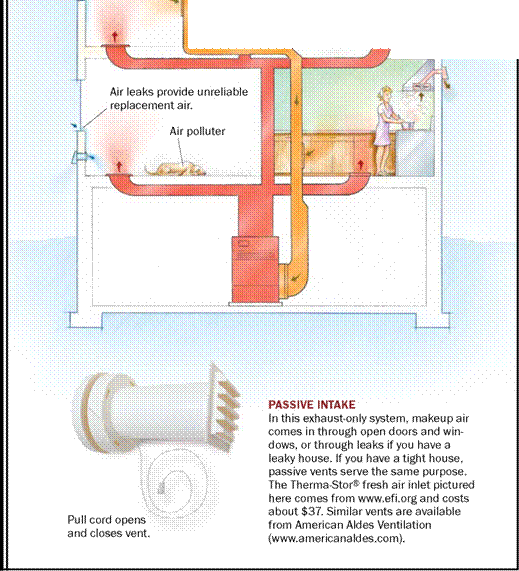Good Ventilation: Different Paths to the Same Place
When ventilation removes contaminants, it’s your friend, but in doing so, it usually brings in outdoor air that must be heated, cooled, or dehumidified, which costs money. Just because it costs money, though, doesn’t mean ventilation is your foe. The energy savings of a tight house more than offset the operating cost of a small fan, not to mention the costs of asthma and allergy medications. The trick is to design a ventilation system that provides acceptable indoor air as efficiently as possible. The system’s design depends on where you live, but the ASHRAE ventilation standard can guide you through alternatives. Every ventilation system likely will be a little different. In general, though, there are three approaches to whole-house ventilation—exhaust, supply, and balanced systems—each a little more involved and more expensive than the last.
Exhaust Ventilation Clears Pollutants at Their Source
The simplest system, exhaust only, provides mechanical ventilation with a continuously operating exhaust fan (see the drawing on the facing page). This fan can be as simple as upgrading your bath fan or as complex as installing a multi-room exhaust fan. The exhausted air is replaced by air infiltrating through leaks (in humid climates, this can cause moisture problems). But rather than doing so at the whim of the weather, it is being done at a steady level with the fan. With the quiet, energy-efficient fans available today, this option is cheap and easy. Because its makeup-air requirements are small, a low-volume exhaust fan won’t depressurize your house enough to cause backdrafting. This system also has the advantage that it can be used in homes without ductwork.
The simplest way to make sure contaminants don’t build up in a house is to suck them out with one or more continuously running exhaust fans. This approach is the least expensive, is the least invasive, and has the advantage of working in houses without existing ductwork. For whole-house ventilation, existing kitchen and bath fans must be left running, a noisy prospect unless you have super-quiet models. A better solution is to use a multiport fan (see the drawing on p. 36) in the attic to exhaust many rooms simultaneously.
|
||||||||||
|
||||||||||
 |
|
|||||||||
|
||||||||||



Three Design Choices for Hot, Humid Climates
|
I |
n a hot, humid climate, drawing fresh air into a house can be a problem. You can inadvertently introduce 8 gal. of water a day from ventilation air. When combined with internally generated moisture sources, this is way too much. There are three design options to consider or combine.
1. Tolerate
You can accept periods of high moisture levels if you use moisture-tolerant materials. Hard, cleanable surfaces are better choices than fuzzy ones. Use hardwood floors instead of carpet, or tile, plaster, or brick rather than paperfaced drywall.
2. Desiccate
Get the extra moisture out of the air by condensing it and draining it. Air conditioners can remove moisture, but they usually are sized and designed for controlling temperature.
In some climates, they won’t dehumid – ify enough under normal use. A better option is a standalone dehumidifier or enhanced dehumidification gear.
3. Procrastinate
Some humid climates have dry seasons. It might be possible to use reservoir-type buffer materials that store moisture during hot, humid periods, then release it during dry ones. Examples of such materials are brick interior walls, cellulose insulation, and solid-wood exposed beams.
A downside is that this system blows out heated (or cooled) air and, therefore, wastes energy. Another downside is that you don’t know where the ventilation air being sucked in is coming from (or where it has been).
Air from a garage or other polluted space shouldn’t be inadvertently brought into a house. Passive-intake vents are a simple way to offset this problem (see the photo on p. 33).






Leave a reply